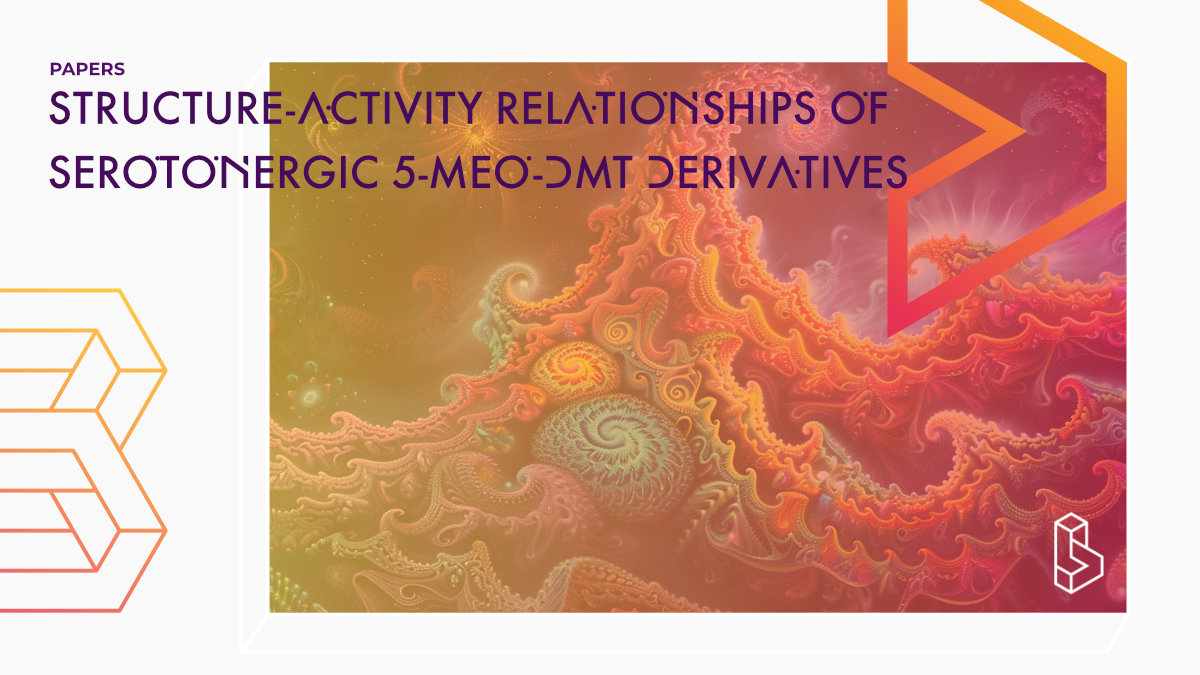This cell & mice study explores the psychopharmacological profile of amino-substituted 5-MeO-tryptamines, focusing on their interactions with serotonin receptors and transporters, as well as their psychoactive and thermoregulatory properties. The study demonstrates selectivity for 5-HT1AR over 5-HT2AR among examined compounds using radioligand binding methodologies and computational docking analyses, and 5-MeO-pyr-T was identified as the most potent partial 5-HT releaser.
Abstract of Structure-activity relationships of serotonergic 5-MeO-DMT derivatives: insights into psychoactive and thermoregulatory properties
“Recent studies have sparked renewed interest in the therapeutic potential of psychedelics for treating depression and other mental health conditions. Simultaneously, the novel psychoactive substances (NPS) phenomenon, with a huge number of NPS emerging constantly, has changed remarkably the illicit drug market, being their scientific evaluation an urgent need. Thus, this study aims to elucidate the impact of amino-terminal modifications to the 5-MeO-DMT molecule on its interactions with serotonin receptors and transporters, as well as its psychoactive and thermoregulatory properties. Our findings demonstrated, using radioligand binding methodologies, that all examined 5-MeO-tryptamines exhibited selectivity for 5-HT1AR over 5-HT2AR. In fact, computational docking analyses predicted a better interaction in the 5-HT1AR binding pocket compared to 5-HT2AR. Our investigation also proved the interaction of these compounds with SERT, revealing that the molecular size of the amino group significantly influenced their affinity. Subsequent experiments involving serotonin uptake, electrophysiology, and superfusion release assays confirmed 5-MeO-pyr-T as the most potent partial 5-HT releaser tested. All tested tryptamines elicited, to some degree, the head twitch response (HTR) in mice, indicative of a potential hallucinogenic effect and mainly mediated by 5-HT2AR activation. However, 5-HT1AR was also shown to be implicated in the hallucinogenic effect, and its activation attenuated the HTR. In fact, tryptamines that produced a higher hypothermic response, mediated by 5-HT1AR, tended to exhibit a lower hallucinogenic effect, highlighting the opposite role of both 5-HT receptors. Moreover, although some 5-MeO-tryptamines elicited very low HTR, they still act as potent 5-HT2AR agonists. In summary, this research offers a comprehensive understanding of the psychopharmacological profile of various amino-substituted 5-MeO-tryptamines, keeping structural aspects in focus and accumulating valuable data in the frame of NPS. Moreover, the unique characteristics of some 5-MeO-tryptamines render them intriguing molecules as mixed-action drugs and provide insight within the search of non-hallucinogenic but 5-HT2AR ligands as therapeutical agents.”
Authors: Pol Puigseslloses, Núria Nadal-Gratacós, Gabriel Ketsela, Nicola Weiss, Xavier Berzosa, Roger Estrada-Tejedor, Mohammad Nazmul Islam, Marion Holy, Marco Niello, David Pubill, Jordi Camarasa, Elena Escubedo, Harald H. Sitte & Raúl López-Arnau
Summary of Structure-activity relationships of serotonergic 5-MeO-DMT derivatives: insights into psychoactive and thermoregulatory properties
Introduction
Tryptamines have seen an increased growth in recent years, parallel to the growth in “modern shamanism”, a new trend in drug experimentation consisting of the exploration of the inner-self.
Tryptamines are a class of drugs with an indole scaffold, an amino group and an ethyl side chain, resembling the structure of serotonin. 5-methoxy-substituted tryptamines have been widely experimented by users, and have been associated with several cases of intoxications and fatalities.
Find this paper
https://doi.org/10.1038/s41380-024-02506-8
Open Access | Google Scholar | Backup | 🕊
Cite this paper (APA)
Puigseslloses, P., Nadal-Gratacós, N., Ketsela, G., Weiss, N., Berzosa, X., Estrada-Tejedor, R., ... & López-Arnau, R. (2024). Structure-activity relationships of serotonergic 5-MeO-DMT derivatives: insights into psychoactive and thermoregulatory properties. Molecular Psychiatry, 1-13.
Study details
Compounds studied
5-MeO-DMT

